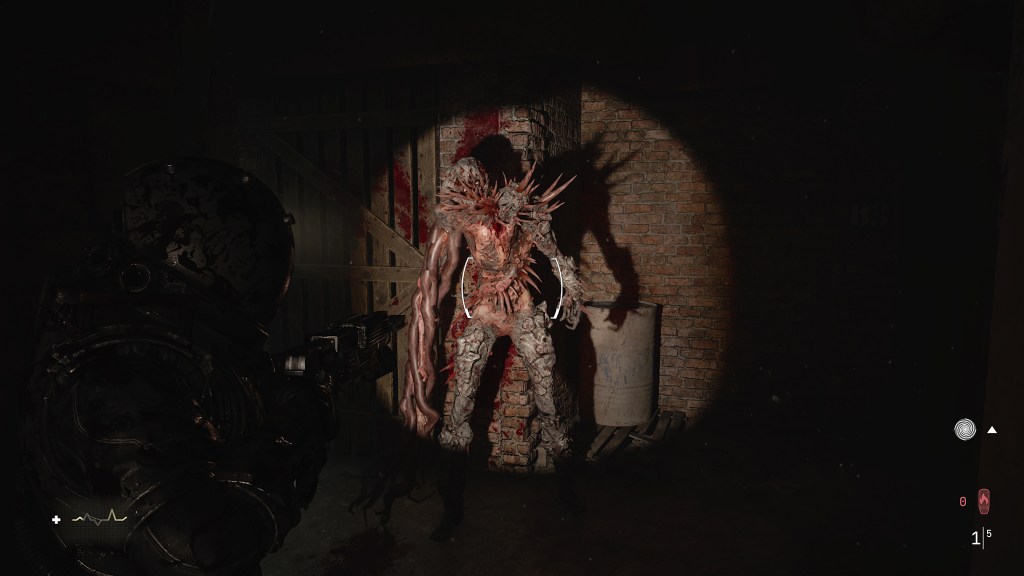Bloober Team getting the reins to Silent Hill initially felt unfair. The team spent nearly a decade churning out laughable, poorly assembled horror games only to get the keys to one of the genre’s finest. It didn’t add up. However, Bloober’s thoughtful Silent Hill 2 remake marked a turning point, a reimagining that expanded on the source material while still showing a deep reverence for its crushing atmosphere and layered storytelling. Cronos: The New Dawn is the first real test that Bloober can hang with the horror heavyweights when it isn’t lovingly tracing over a classic. Yet despite that newly gained experience, Cronos is a miserable title dragged down by a lot of the same old frustrations that have plagued Bloober’s prior games.
Videos by ComicBook.com
Cronos is, at least, more of a game. Instead of being a horror-tinged walking simulator, Cronos is a third-person shooter in the vein of Dead Space and Resident Evil 4, with a slight favoring to the former, given the two armored-clad protagonists. This is a notable development since tiptoeing around for currency and ammo is more engaging and adds the welcome stress of managing an inventory. Beelining straight to the goal in less mechanically dense games is boring and leaves little room for tension to fester, and not being able to feel the fear through the mechanics was a key part of Bloober’s prior failings.
Rating: 2/5
| Pros | Cons |
|---|---|
| Moody, synthy soundtrack | Horribly tuned combat |
Distinct lack of tension and scares | |
| Terribly paced story and dialogue | |
Cynically explored themes |
Cronos‘ Combat Lacks the Deft Touch of Other Horror Games

The transformation into a more gamey video game, while an improvement over tedious walking, is little more than a theoretical upgrade. Gunplay, for example, is thoroughly infuriating for a multitude of reasons. Most guns can shoot normally or be charged for extra oomph, but only the latter seems to actually do any noticeable damage. Orphans, Cronos’ goopy monsters, tank through hits at an alarming frequency — leading to many cheap shots — and hardly react to anything short of a powered-up pellet to the dome or chest. Having to build up power for each shot sounds like it would sow tension, yet it absolutely does not. Bullet sponge enemies who shrug off hits disempower players by making them feel weak.
Disempowerment is seemingly crucial to the genre, but that’s not quite the case with action horror shooters like this. This adrenaline-fueled subgenre is more about overwhelming players than making them feel like they can’t fight, as beautifully shown in Resident Evil 4’s iconic village shootout. Ammo distribution is a key component of this fantasy and yet another way Cronos falters. Boxes or freshly slain Orphans will frequently drop nothing even if ammo is running dangerously low, even during boss battles and more chaotic skirmishes. The thrill comes from always being on the knife’s edge, and the deft resource drops in games like Dead Space, The Last of Us, and Resident Evil 4 ensure the player is perpetually on that precipice when played on most difficulties. Cronos severely lacks this deftness and pays the price — running out of bullets is a huge pain and pushes players out of that riveting Goldilocks zone.
Artificial ammo scarcity is partially a symptom, though, as it’s a byproduct of the aforementioned spongy enemies as well as the lack of any suitable alternatives to traditional firearms. Melee strikes are slow and functionally useless, and there are no other reliable ways to slaughter without firing off a bullet or grenade. The game’s limited-use flamethrower wastes its potential by having such few charges and not automatically refilling, two oversights that radically diminish its utility. Melee weapons and telekinetic gadgets in other games aren’t just there for variety’s sake; they play a crucial role in combat balancing by making a low ammo count not as much of a death sentence.
Cronos Isn’t Scary (and That’s a Big Problem)

Cronos’ combat, in addition to being stingy and tedious, also just lacks an identity. The enemy merging mechanic that is supposed to give Cronos its own sauce, ironically, never comes together. Grunts can inherit additional powers like armor or acid-spitting from nearby carcasses, but it rarely happens and only once again highlights the game’s other issues. Enemies don’t aggressively merge with each other because that would only make the paltry amount of flamethrower fuel used to torch corpses even more apparent. And when they do merge, it’s not always a given there will be enough ammo to deal with the newly formed deadlier hybrid. Cronos also never twists or plays with this mechanic, so there’s nothing to keep players on their toes. It’s an excellent idea in theory, but executed in such a limited and half-baked fashion, rendering the whole thing a huge bust.
Cronos also isn’t scary enough to make up for its dreadful action. Jump scares are almost always extremely rinky-dink, Alan Wake 2-esque full-screen flashes with loud screams or pedestrian “monster bursts through door” sequences (which, for some godforsaken reason, punishes non-clairvoyant players by damaging them if they’re even remotely close). These sit alongside the more pathetic sequences that suddenly teleport players into a different enemy-filled dimension before cutting back at the last second and having objects slowly move forward or fall as if they’re possessed. It’s all wildly hacky, and there’s been little done to cleverly surprise players or make them fear every hallway. There is one grabby, wall-bound enemy type that forces careful scanning of each surface, and those can instill a welcome bit of paranoia, but they’re repeated so often and cumbersome to track down because of their poorly mixed audio cues.
Most of these walls caked in viscera and collections of undulating undead are part of what gives Cronos an appealing style. The mechanical, cassette futurism aesthetic of its bulky technology mixed with the unending masses of fused flesh is not unique, per se, but it is realized relatively well here to create some eye-catching vistas and some wonderfully tactile hardware reminiscent of the 1980s. The soundtrack further reinforces this retro setting through its compilation of synths that are simultaneously creepy and comforting, a line perfectly straddled by its infectious save room track.
Cronos‘ Cynical Narrative Veers off the Rails

Aesthetics are important, but the meat of Cronos’ worldbuilding and narrative is, as evidenced by its embarrassing abundance of cliché blood graffiti, weak. Cronos’ real-world roots in 1980s Soviet-era Poland make for a rich historical tapestry to pull from, and the game implies it will dig into the political themes baked into that time period. With the masses congealed into unified blobs and the failed rule of its authoritarian regime, there’s plenty of room to make compelling sci-fi-tinged commentary about individualism and collectivism.
It begins to go down this route in disconcerting ways by seemingly implying working together only leads to more destruction, as evidenced by how it negatively portrays or looks down upon quarantines, worker-led efforts, and religion. When worker exploitation and the greed of the few is ushering in Gilded Age levels of inequality, isolation is rattling people’s brains, and rugged individualism is gutting valuable institutions and contributing to moral decay, it’s borderline irresponsible to broadly and repeatedly depict attempts at forming communities or coming together as imminently dangerous. It is also unconvinced with delivering a nuanced examination of these topics or offering even the smallest crumb of a counterpoint, instead choosing to stew in its elementary cynicism.
Silly late-game twists jettison most of these threads, though, opting to refocus the last chunk on an out-of-place storyline that muddles whatever it was previously working toward. It’s possible (if unlikely) the other endings offer something optimistic or are at least more coherent, but Cronos is too long and not something that begs to be replayed, despite its inclusion of New Game Plus. The mystery at the center of it all is doled out so laboriously and saps any narrative momentum it has trouble building in the first place, an annoyance on the first run that all but negates the will to do another. It isn’t helped by its dry characters who speak so lethargically and monotonously as if they are also bored by how slowly it is all moving.
Cronos’ sweeping narrative issues speak to how thoroughly troubled the entire game is. Like the humanoid blobs that coat many of its buildings and streets, Cronos is an amalgamation of ideas that combine to form a messy whole. Its clumsily balanced combat is aggravating and regularly disempowers players, and its inane attempts at providing scares are woefully ineffective. And when underpinned by a badly paced narrative with questionable themes, Cronos: The New Dawn is anything but a new dawn for Bloober and is instead a remix of its same old deficiencies.
A PS5 copy of Cronos: The New Dawn was provided by the publisher for the purpose of this review.









